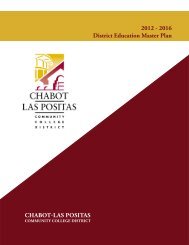City College of San Francisco - California Competes
City College of San Francisco - California Competes
City College of San Francisco - California Competes
You also want an ePaper? Increase the reach of your titles
YUMPU automatically turns print PDFs into web optimized ePapers that Google loves.
THEME I<br />
I. Overview<br />
This essay provides the institutional context for a case study that focuses on basic skills programs within<br />
the <strong>College</strong> as an illustration <strong>of</strong> the institution’s commitment to high-quality education. It first defines<br />
“institutional commitment” and “high-quality education,” providing an overview <strong>of</strong> how we achieve<br />
both. It then discusses the alignment <strong>of</strong> CCSF’s Mission with the planning process and describes how this<br />
process yields strategic priorities for the <strong>College</strong> that can readily be mapped back to the Mission. One <strong>of</strong><br />
CCSF’s eight strategic priorities focuses solely on basic skills, and the need for attention to basic skills is<br />
referenced throughout the remaining priorities. This fact, along with the foundational importance <strong>of</strong> basic<br />
skills mastery for greater student success in subsequent coursework, underpins the rationale for selecting<br />
basic skills as a case study that illustrates how the institution demonstrates a commitment to high-quality<br />
education through this focus. The case study, then, chronicles the evolution <strong>of</strong> CCSF’s emphasis on basic<br />
skills generally, and describes, in particular, interventions implemented as the result <strong>of</strong> grant funding in<br />
the two areas <strong>of</strong> greatest need, English and Math; the ways in which the institution measures progress<br />
and uses that information to inform practice at the classroom, direct service, and administrative levels;<br />
and how the institution continues to promote and support this emphasis through resource development,<br />
policy changes, and structural modifications.<br />
II. Institutional Context<br />
The Meaning <strong>of</strong> Institutional Commitment to High-Quality Education. WASC, through Standard I.B.,<br />
suggests that an institution exhibits “commitment” when it “demonstrates a conscious effort to produce<br />
and support student learning [through measuring, assessing, and adapting learning as necessary] … [and]<br />
organizes its key processes and allocates its resources to effectively support student learning.” Similarly,<br />
“high-quality education,” as defined by the contents <strong>of</strong> WASC Standard II, centers around the extent to<br />
which programs are “systematically assessed in order to … improve teaching and learning strategies and<br />
achieve stated student learning outcomes” and the extent to which the college “identifies and seeks to<br />
meet the varied educational needs <strong>of</strong> its students consistent with their educational preparation and the<br />
diversity, demographics and economy <strong>of</strong> its communities” through the use <strong>of</strong> appropriate “delivery<br />
modes and teaching methodologies,” recognizing throughout the “central role <strong>of</strong> its faculty for establishing<br />
quality and improving instructional courses and programs.” This definition encompasses instruction,<br />
student support, and other services.<br />
A Bird’s-Eye View <strong>of</strong> CCSF’s Commitment to High-Quality Education. CCSF is committed to highquality<br />
education (including academic programs, student support, and other services) at all levels through<br />
130 certificate programs, 34 awards <strong>of</strong> achievement, and 11 formal majors. One <strong>of</strong> CCSF’s largest programs<br />
(second to English as a Second Language, as indicated below), is its School <strong>of</strong> Business, employing roughly<br />
150 faculty. Up to 60 percent <strong>of</strong> all students who transferred to <strong>San</strong> <strong>Francisco</strong> State University from CCSF<br />
began their college education in the School <strong>of</strong> Business; this statistic serves as an indicator suggesting that<br />
the School <strong>of</strong> Business’ educational programs are <strong>of</strong> high quality. While CCSF continues to deliver and<br />
assess its traditional academic programs, <strong>of</strong>ten on a large scale as in the case <strong>of</strong> Business, it also explores<br />
new frontiers in response to industry need in other areas <strong>of</strong> study. For example, the innovative “Design<br />
Collaborative” brings together faculty from Architecture, Art, Graphic Communications, Multimedia<br />
Studies, and Photography to develop design-related courses, leading to a formal major in design that<br />
addresses the needs <strong>of</strong> the local design community by virtue <strong>of</strong> promoting collaboration across<br />
design-related disciplines.<br />
CITY COLLEGE OF SAN FRANCISCO<br />
245







